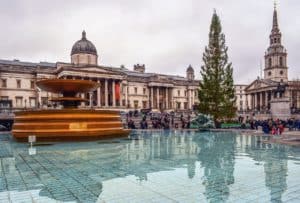The Iconic Big Ben: London’s Timeless Landmark

Updated On: November 18, 2023 by Noha Basiouny
At the heart of London’s bustling metropolis stands Big Ben, an iconic symbol of both the city and the United Kingdom that has captivated locals and visitors alike for over a century. Officially known as the Elizabeth Tower, but affectionately referred to by its nickname, Big Ben, the clock tower’s majestic presence and the sonorous tolling of its bell have become synonymous with the identity of the Swinging City.
Beyond Big Ben’s impressive facade lies a rich history, engineering marvels, and political symbolism. From its construction in the mid-19th century to its role in major historical events, the tower has witnessed the evolution of London and the wider world.
In this article, we are exploring this majestic world-renowned landmark, digging deeper into the intricate details of its architecture, the significance of its timekeeping, and its place in the cultural and political landscape of the United Kingdom.
Big Ben
Situated at the north end of London’s Palace of Westminster, Big Ben is a significant architectural achievement for its time, especially for its clock, which is one of the largest and most accurate public timepieces in the world. Big Ben is also a prominent symbol of the United Kingdom and parliamentary democracy and is often used in the media and popular culture to signify the time in London.
As one of the UK’s key tourist attractions, this iconic landmark is a focal point for New Year’s Eve celebrations in the UK, with its chimes marking the start of the new year, an event annually broadcast live by the BBC on 31 December. The melody played by the clock’s bells is known as the Westminster Quarters and is replicated in clocks and chimes worldwide.
Interestingly, the tower was originally known as the Clock Tower, while the nickname “Big Ben” actually referred to the 13.5-tonne Great Bell striking inside the clock. The tower was then renamed the Elizabeth Tower in 2012 to honour Queen Elizabeth II’s Diamond Jubilee. Now, the term Big Ben is often used to refer both to the clock and the clock tower.
Before the major renovation project that began in 2017 and included adding a lift, visitors had to climb 334 steps in order to reach the belfry of the Elizabeth Tower, where the Great Bell is located. This climb offered a close-up view of this iconic timepiece and its inner workings.
Construction
Big Ben is not a stand-alone structure but rather part of the design for the new Palace of Westminster—home to the Parliament of the UK—which was reconstructed following a devastating fire that destroyed much of the original medieval complex in 1834.
The inclusion of a towering clock, much like the palace itself, symbolised the United Kingdom’s strength, stability, and grandeur, as well as the importance of time and punctuality in parliamentary democracy.
Along with that, the tower is a reflection of the technological creativity and advancement that distinguished the mid-19th century in the UK. The construction of a clock tower with one of the largest and most accurate four-faced chiming and striking clocks in the world was a testament to British engineering and innovation.
Architectural Details
The design of Big Ben is a remarkable blend of Gothic Revival architecture and Victorian engineering. It was created by Augustus Pugin and was completed in 1859 as part of Charles Barry’s design for the new Palace of Westminster, which itself was not completed until 1876.
Here is a detailed look at each component of the Clock Tower:
Elizabeth Tower
As we just mentioned, the tower is designed in the Gothic Revival style, which was quite popular in the mid-19th century. It was primarily built of brick and Anston limestone, which gives it a distinct, sandy colour. The exterior of the tower is embellished with intricate stonework, including carvings, fretwork, and spires.
With a height of 96 metres, the tower features a square base, measuring 12 metres on each side, projecting buttresses at the corners, and pinnacles, which add to its Gothic character.
The Clock
There are four clock faces on the tower, each seven metres in diameter, set in an iron frame and including panels of opal glass. The clock dials are designed in a lavish style with Gothic motifs. Roman numerals are used for the hours, and the design includes fleur-de-lys patterns for the minutes.
Initially, the dials were illuminated by gas, but they have been lit by electric lights since the early 20th century. The hour hand is as long as 2.7 metres, and the minute hand measures 4.3 metres, and both are made of cast iron.
The clock itself is so famous for its reliability and accuracy that it has rarely stopped, and this is attributed to many factors. First of all, the clock tower is designed to be isolated from ground movement and vibration, ensuring the clock’s accuracy is not affected by external factors.
The clock mechanism is also a masterpiece of 19th-century engineering, featuring a pendulum where adjustments are made by adding or removing old British penny coins on top of it. Each penny added or removed changes the clock’s speed by approximately 0.4 seconds per day.
Another thing that is carefully maintained to ensure the clock’s accuracy and reliability is that it undergoes regular maintenance and preservation.
The Great Bell
The Great Bell weighs about 13.5 tonnes. It is 2.29 metres tall and 2.74 metres in diameter. However, this is not the original bell that was intended to be installed in the tower. The initial bell, cast in 1856, cracked while testing due to its size and never actually made it to the tower.
A new bell, the current Big Ben, was cast at the Whitechapel Bell Foundry in East London in 1858. It was transported to the tower and installed in July 1859.
Just two months after it was installed, in September 1859, this new bell cracked. The crack was attributed to a heavy hammer and the bell’s angle in the belfry. Rather than recasting, the bell was turned slightly, and a smaller hammer was used to strike it. A square piece was also cut out of the bell around the crack to prevent it from spreading further.
The crack and the subsequent modifications changed the tone of the bell a little bit, but it still chimes with a distinctive sound that has been broadcast by the BBC since 1923, except for maintenance and repair periods.
The Quarter Bells
Besides the Great Bell, there are four quarter bells that chime every 15 minutes. These bells play the same Westminster Quarters melody used by Big Ben to mark each quarter-hour.
All four bells range in diameter between 1.1 and 1.8 metres, and their weight is proportionally different, too, so as to produce different tones that harmonise with the Great Bell.
The Ayrton Light
The Ayrton Light is a lantern-like structure installed at the top of the Elizabeth Tower in 1885. It was requested by Queen Victoria so she could see from Buckingham Palace when Members of Parliament were sitting after dark, and it was named after Acton Smee Ayrton, a liberal politician and the First Commissioner of Works between 1869 and 1873.
In 1903, the Ayrton Light was converted to electricity, marking a significant upgrade from its original power source. This conversion happened a few years before the clock-dial lighting of the tower was changed from gas to electricity in 1906.
Other Components
Above the belfry and the Ayrton Light are 52 shields decorated with national emblems representing the United Kingdom’s four countries: England, Scotland, Northern Ireland, and Wales. These emblems include the Tudor rose of England, the thistle of Scotland, the shamrock of Northern Ireland, and the leek of Wales, symbolising the unity and diversity of the UK.
The tower contains various maintenance rooms and spaces for the clock’s caretakers as well. It also has two small prison rooms, which were historically used to detain Members of Parliament for breaches of parliamentary protocol.
Endurance During the Two World Wars
Big Ben’s remarkable survival during the World Wars, especially World War II, stands as a symbol of resilience and steadfastness in the face of adversity.
During World War II, precisely in 1941, London was subjected to relentless German bombing raids known as the Blitz, which caused widespread destruction across the city.
Although the Clock Tower sustained some damage; for instance, its roof and dials were destroyed, it continued to toll throughout the war, serving as a constant and reassuring presence amidst the chaos and destruction. Its survival was not just a feat of structural endurance; it became a symbol of hope and defiance for the British people in an era marked by uncertainty and fear.
The resilience of Big Ben during these tumultuous times was not only significant for the British but also for the world. Despite facing the threat of bombings, the British government decided against silencing the bell, a decision that further underscored its symbolic importance. This choice resonated deeply, portraying an image of Britain’s unwavering spirit.
Big Ben in Pop Culture
Big Ben transcends its physical role as a clock tower, becoming a symbol of London’s enduring spirit, its historical depth, and its capacity for wonder and adventure. This made it a versatile and evocative element in popular culture.
For instance, Big Ben appeared in both classic and contemporary literature, often symbolising adventure, history, and the vibrant life of the city. Its iconic status has also made it a popular reference in songs and music videos across various genres.
Likewise, the clock tower has inspired artists and photographers, becoming a subject for various artistic interpretations. It was depicted in pop art and street art and became a must-photograph location for tourists. Besides, the image of Big Ben is used in merchandise and souvenirs ranging from postcards, key rings, and t-shirts to detailed scale models, showcasing its commercial appeal as well.
Role in New Year’s Eve Celebrations

Big Ben plays a key role in the UK’s New Year’s Eve celebrations. The striking of the bell at midnight is a significant moment, marking the end of an old year and the beginning of a new one. It is a moment of national and often emotional significance, representing both reflection and new beginnings.
The chimes of Big Ben at midnight are broadcast across the country and are watched by millions on television and online. The area around the Palace of Westminster, including the Thames River, becomes a focal point for these festivities in London. Spectacular fireworks displays are often synchronised with the chimes of Big Ben, adding to the celebratory atmosphere.
Renovation and Conservation
Being an old structure already, the tower faces typical challenges such as erosion and damage to the stonework. Pollution and weather conditions in London contribute to the deterioration of the exterior, too.
That is why the maintenance and conservation of Big Ben have been crucial in preserving its status as a working symbol of British history and engineering. These efforts are typically divided into regular maintenance for the major parts to ensure the clock and the bells continue to work just as fine and also major renovation projects that aim to repair the harm done over a prolonged period of time.
For instance, the clock mechanism undergoes regular maintenance to ensure its accuracy. This involves cleaning, oiling, and adjusting the clockwork. The Great Bell and the Quarter Bells are also inspected and maintained regularly. This typically includes checking for and repairing any damage to the bells and their clappers. The clock faces are also cleaned and maintained, ensuring the glass and illumination are in good condition.
The first significant restoration of the tower took place in the mid-1980s. It included dismantling and cleaning each component of the clock, repairing the tower’s stonework, and repainting the ironwork.
However, the most extensive conservation work undertaken on the Elizabeth Tower in its entire history started in 2017. Here are some key aspects of this project:
- The project involves repairing the stonework, regilding and repainting the ironwork, and addressing water damage.
- The clock mechanism is being dismantled and restored, with each piece being carefully cleaned and repaired.
- The addition of an elevator and improvements to energy efficiency are part of the renovation.
- Improvements are being made to make the tower more accessible to people with disabilities.
This crucial restoration involved the collaborative efforts of over 500 individuals from various parts of the UK, showcasing their traditional skills in stone masonry, glass blowing, gilding, plastering, cast iron work, and clock mechanics.
Visiting Big Ben

Embarking on a journey through the Elizabeth Tower and ascending the slender spiral staircase of 334 steps to reach the belfry is a captivating, once-in-a-lifetime experience that anyone ever making it to London should not miss.
Tours are usually enriched with fascinating insights provided by a guide about the tower’s most comprehensive and intricate restoration effort to date. They offer a distinct opportunity to witness the clock’s intricate mechanism up close, stand beside the globally acclaimed Big Ben as it chimes, and view the massive clock faces.
However, the Big Ben tour may not be suitable for everyone. It requires participants to be at least 11 years old, able to climb 334 steps and tolerate loud sounds from the clock and bells, for which earplugs are provided. The tour lasts approximately 90 minutes, with restroom facilities accessible only at the start and end. Currently, the tower does not offer accessible tours with step-free options.
Anyone wishing to climb up Big Ben can get more information about the tours and availability of tickets from the UK’s Parliament website.
As we reflect on its history, from the precision of its engineering to its role as a witness to pivotal moments in time, Big Ben emerges as more than just a structure; it is a symbol of continuity amidst change and a beacon of tradition in a modern metropolis. It is an enduring emblem of London’s resilience and architectural elegance.
While it continues to chime above the River Thames, Big Ben reminds us of the enduring power of heritage and the timeless charm of London, inviting generations to come to marvel at its grandeur and historical significance.






